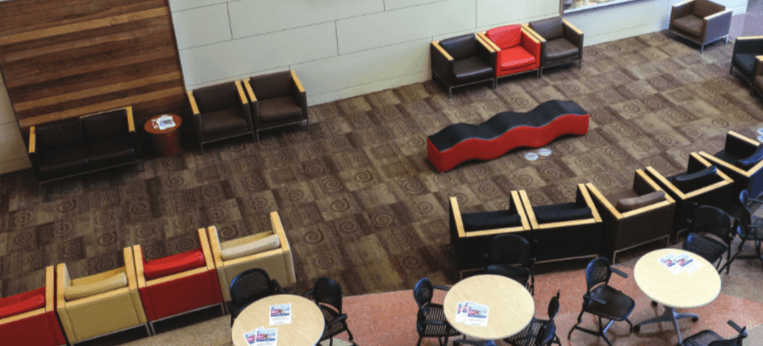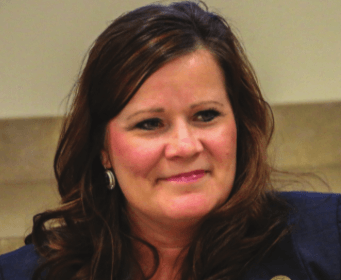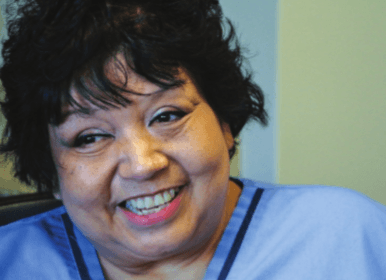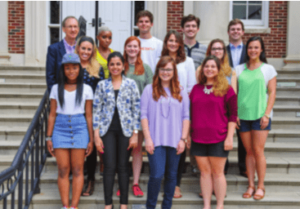Headlines
Unconquered And Unconquerable: A Haven For Healing
“It’s not uncommon to see a camper in the parking lot because patients have come so far.”

The Chickasaw Medical Center in Ada is a model for Native American health care. Even the interior décor is tribal.
As a little girl, Judy Parker was always running up and down hospital hallways with her brothers, driving nurses crazy by setting off false alarms in the emergency room.
No one would’ve guessed the little prankster would one day become Judy Parker, Ph.D, secretary of health for the Chickasaw Nation and overseer of the spacious Chickasaw Nation Medical Center in Ada, Okla.
A crown jewel of the Chickasaws, the medical center is not just a hospital. It is also a statement of modern art, a building that feels more like a testimony to nature than a standard medical facility.
The $146 million center was built in 2010 in order to accommodate a growing tribe and to overcome treatment issues within the nation. With 72 hospital beds, a roomy diabetes care center and a women’s health center, the tribe can offer first-class care to its citizens at a time when many other tribes’ health facilities are under fire. The center also boasts a 3-D breast scanner to help detect cancer, the latest heart-imaging technology and the capacity to fill more than 1 million prescriptions a year.
But health care wasn’t always this accommodating in the Chickasaw Nation. The old Carl Albert Hospital was just over a third of the size of the new facility, forced to handle more than 10 times the number of patients it was built for.
The old hospital could fit into the first floor of the outpatient side of the new health center, Parker said.
“We’ve increased, of course, by a lot of square feet and by about 400 employees when we moved from the old facility to the new facility,” she said.
No one may be as attached to the medical center as Parker, whose father was an X-ray and lab technician for years in the old digs. His influence helped her decide to pursue a nursing degree, which in time became a Ph.D.
“My dad had a great love for healthcare and actually ended his career there. You know, he was volunteering at the hospital the last job that he had,” Parker said. “He worked in healthcare all of his life. I grew up hearing about it and just having a real love for that.”
Parker was hired as health administrator for the Chickasaw Nation in 2009 and is a member of Gov. Bill Anoatubby’s Cabinet.

As this lobby shows, the hospital boasts a myriad of aesthetic design elements.
“I’ve been encouraged by Gov. Anoatubby to improve the health of all Chickasaw people, whether they’re a patient here or live here in the Chickasaw Nation or even in some other state. It’s a big charge,” she said.
A big charge comes with big responsibility, especially for a nation known for its high number of type 2 diabetes cases.
According to Parker, there is something different about Native Americans, something that can affect their health.
“The way our bodies respond to the foods that we eat is also different, which increases our risk for diabetes,” she said.
No wonder the new medical center so prominently features a diabetes clinic, where doctors and nurses evangelize patients in hopes of getting them to battle the disease by changing to a healthier lifestyle. The clinic employs an endocrinologist, nurse practitioner, behavioral health employee and even a dental hygienist.
“I think it shows that diabetes care is elevated,” Parker said. “It has its own special clinic, own special footprint.”
The clinic in the old hospital was housed in a 20 foot-by-20 foot room with only four staffers, Parker said. Now, patients can take advantage of exercise therapy, get routine checkups and even go to cooking and nutrition classes – all in just one part of the facility.
The hospital also houses a women’s clinic, which recently logged 100 baby births in a month. To Parker, it’s a big milestone.
Aside from its medical offerings, the hospital boasts a myriad of aesthetic design elements, which differ from the sterile, empty hallways of its contemporaries. The idea is to make patients more relaxed, more comfortable.

Marty Wafford has seen campers waiting in the parking lot with patients “from California, way down Texas.
“We had a lot of input from our elders and also people in our tribe who are very familiar with the culture,” said Parker.
The design incorporates different elements of Chickasaw culture. Sweeping scallops of diamond netting create a central pattern along its textured passages, and a continuous flow of tiny details crown the neck at the center where it effuses energy like a heart pumping blood out to the limbs.
From the diamond patterns on the floor, inspired by a traditional beaded Chickasaw collar, to the natural blues, yellows and greens of the interior, the building does its best to mimic nature. Large windows let natural light fall across corridors, creating a mirage of dancing reflections on the copper fixtures.
Patient rooms are larger than at most hospitals, allowing many family members to visit a patient at the same time. That adheres to Chickasaw tradition, which holds that the presence of family contributes to healing. No family member is ever asked to leave a room if a patient does not wish them to.
On another part of the grounds, the center owns what it calls “the Chikasha House,” a free haven for families visiting long-term patients. Since beginning operation in 2013, it has assisted more 1,000 families.
Every room at the medical center looks out across a manicured lawn bordered by a wooded area. The idea is that no patient should ever have to look over a parking lot or see concrete while staying here.
“Our patients, in all of their rooms, when they look out the window they see beautiful surroundings. Sometimes deer on the lawn, turkeys, other wildlife,” Parker said. “It’s so pretty. Pretty and green.”
The medical center has four satellite clinics — in Ardmore, Durant, Purcell and Tishomingo. All have been updated to echo the design of the new center.
Judy John has worked for the Tishomingo clinic for 18 years. She’s a health information management clerk and a first-hand witness to the drastic changes in Chickasaw health care.
John is also a tribe member. And she has diabetes.

Judy John, a health information management clerk at the tribe’s Tishomingo clinic, had two of her seventeen grandchildren born in the women’s clinic.
“I used to go to the hospital for my health care and there’d be a whole line sitting there to get checked in. Sometimes people would rush, try to get hurrying and get checked in when they open the window,” John said. “Now, it’s amazing. You can go get checked in right there at the clinic, and they call you right as soon as you get there.”
John has 17 grandbabies, two of whom were born in the women’s clinic at the medical center. She praised the family atmosphere and said everything was “easy” in the new clinic.
But her first love is the clinic in Tishomingo.
“I enjoy working with the patients here,” John said. “I can’t believe I’ve been here 18 years.”
Chickasaw health care doesn’t just cater to the needs of its own tribe. With the proper paperwork, any Native American tribe member can receive free services. As the center’s reputation has spread, it has become a beacon for Native Americans across the country.
Marty Wafford, undersecretary of support for the Chickasaw Nation Department of Health, has seen patients come from “everywhere.”
“It’s not uncommon to come to work in the morning on a Monday or Thursday, Friday, whatever, and see a camper in the parking lot because patients have come so far,” Wafford said. “Patients even come from California, way down Texas, annually. They’ll come and you’ll see them.”
By Taylor Bennett. Photography by Chi Kalu.

LEFT TO RIGHT: Ariel Cobbert, Mrudvi Bakshi, Taylor Bennett, Lana Ferguson, SECOND ROW: Tori Olker, Josie Slaughter, Kate Harris, Zoe McDonald, Anna McCollum,
THIRD ROW: Bill Rose, Chi Kalu, Slade Rand, Mitchell Dowden, Will Crockett. Not pictured: Tori Hosey PHOTO BY THOMAS GRANING
The Meek School faculty and students published “Unconquered and Unconquerable” online on August 19, 2016, to tell stories of the people and culture of the Chickasaw. The publication is the result of Bill Rose’s depth reporting class taught in the spring. Emily Bowen-Moore, Instructor of Media Design, designed the magazine.
“The reason we did this was because we discovered that many of them had no clue about the rich Indian history of Mississippi,” said Rose. “It was an eye-opening experience for the students. They found out a lot of stuff that Mississippians will be surprised about.”
Print copies are available October 2016.
For questions, email us at hottytoddynews@gmail.com.
Follow HottyToddy.com on Instagram, Twitter and Snapchat @hottytoddynews. Like its Facebook page: If You Love Oxford and Ole Miss…





























